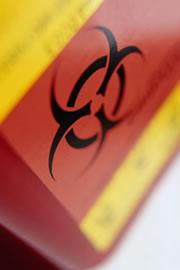When a fire at the chemistry department of the University of Texas, Austin, several years ago required firefighters to enter the labs, they were horrified to discover that there were inflammable substances inside. The department briefly faced the threat of having to label every door with warnings to that effect ("Danger: this chemistry lab contains ethanol").
Still, it could be worse: they could have been forced to state "Danger: this chemistry lab contains chemicals".
If the ETC Group, an environmental organization based in Ottawa, Canada, has its way, we'll be forced into the same nonsensical bind for nanotechnology. It has announced a competition to design a warning symbol, equivalent to that used to signify biological or radiation hazards, that would be used to identify the presence of nanomaterials. (Proposals so far include the classic yellow triangle for caution containing the image of a microscope, magnifying glass, or buckyball. A small planet Earth being devoured by grey goo is sure to follow.)
Let me see. I guess that means we will need to stick it on every living organism (our bones, for one thing, are full of the nasty stuff). We will put it on computers and CD players and any other device that contains films of material just several nanometres thick - yes, even, redundantly, on the iPod Nano. And the air we breathe will formally become a 'nanohazard', although it's not clear how we might label it.
"Every day laboratory and factory workers could be inhaling and ingesting nanoparticles," the ETC press release says, "while the rest of us may be unwittingly putting them on our skin, in our body or in the environment." But there's no 'could' or 'may' about it - the environment is full of nanoparticles, some of them natural and some human-made. Car exhaust fumes are a major source, for example.
What we have here, then, is another blurring of categories, of the sort that has demonized the words 'chemical' and 'synthetic'. This already does untold damage to any attempts to hold a proper debate about the health and safety, or the broader societal implications, of chemical technology.
Sign of the times
 The biohazard sign says something well defined - but what would a nanohazard symbol mean?Getty
The biohazard sign says something well defined - but what would a nanohazard symbol mean?GettyThe call for a nanohazard warning sign is of course more a publicity stunt than anything else. But the skewed thinking on which it is based could undermine efforts to put much-needed regulation of nanoparticles on a sound footing.
'Nano' is just a term denoting scale (typically 1-100 nanometres). It says nothing about the properties, toxic or otherwise, of the materials concerned. In contrast, the biohazard and radiation symbols are used to denote known, quantified risks.
The fact is that some nanoparticles do seem potentially toxic or dangerous. Preliminary experiments have shown, for example, that some manufactured nanoparticles can damage or kill cells1,2, while there are fears that nanofibres might display asbestos-like biological effects. The potential hazards of nanoparticles in our surroundings are well recognized, if not yet well understood3.
So there is a good case for suggesting that the current use of nanoparticles in some commercial products, such as cosmetics and sun creams, is insufficiently cautious. Because some of the potential problems associated with nanoparticles are a result of their small size rather than their composition, they are not currently covered by existing regulations on toxic substances. That is a loophole that needs closing.
The scientific community is aware of this. The US National Nanotechnology Initiative has earmarked $44 million for the study of health and safety issues. And the UK's Royal Society and Royal Academy of Engineering highlighted nanoparticle toxicity as a serious question in 2004, recommending that until more is known, "the release of manufactured nanoparticles into the environment be avoided as far as possible." There are signs that industry too wants more regulation (see 'Nanotech's big issue'), as uncertainty about risk could scare away investment.
Broad brush
But labelling all nanoparticles as potential killers is neither useful nor sensible. For one thing, it implies that the problem here is in the 'nano' - that there is something intrinsically dangerous about the nanoscale. That's plainly wrong. Such a broad-brush approach would simply breed confusion.
Much of the real risk of nanoparticles depends on the way the materials interact with their environment. In most applications, they won't be free to move around and enter the body. We don't, after all, panic about the arsenic locked away in the lasers of CD players, nor the radioisotopes in smoke detectors. A 'nanohazard' label would make a mockery of toxicology.
ADVERTISEMENT
A nanohazard symbol would be unhelpful, even unfair, to consumers. It would send out the message that something is wrong, whether or not there's any reason to think that. Toxicologists have already warned that the recent highlighting of 'toxic' chemicals, regardless of the dose, in the environment by the World Wildlife Fund is deliberately misleading and introduces unwarranted anxieties. Labelling 'nano' as potentially toxic panders to the popular but false notion that the material world can be divided conveniently into goodies and baddies.
If and when toxicity of a particular kind of nanoparticle is established, we already have a symbol to indicate that. In the meantime, if the ETC Group really wants a 'nanohazard' symbol, I propose that they enter the spirit of the field and write it on the nanoscale - perhaps using DNA-origami4. That's about the size it deserves.
Visit our allnanomaterials_woul.html">newsblog to read and post comments about this story.
-
References
- OberdörsterE., Environ. Health Perspect., 112 . 1058 - 1062 (2004).
- LongT. C., et al. Environ. Sci. Technol., 40 . 4346 - 4352 (2006).
- BiswasP., et al. J. Air Waste Manage. Assoc. , 55 . 708 - 746 (2005).
- RothemundP. W. K., Nature, 440 . 292 - 302 (2006). | Article |

